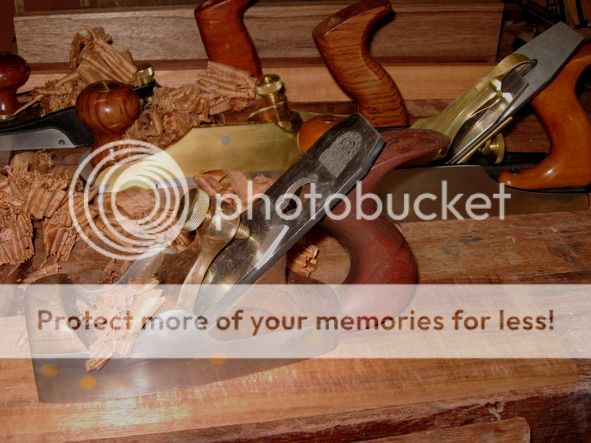Philly":3bdhuwgq said:Possibly :lol:
Although you do have a bigger range of suckage...... :wink:
Philly
How did you know I was speaking in your direction . . .

Philly":3bdhuwgq said:Possibly :lol:
Although you do have a bigger range of suckage...... :wink:
Philly
Then Denis wrote:but what do you get from the BUS that you don't with a LAJ using the same iron?
I agree that the LA Jack is a plane capable of superior performance as a smoother. But its length can have limitations. The longer the plane, the more it will reduce the thickness of a board when smoothing. A short plane rides the hill and valleys. A long plane removes the hills to get to the valleys. That said, Esc probably would not be as affected as his boards are flattened by a jointer before being planed. Still, I like to dedicate a plane as a smoother, and the LA Jack is too versatile to do this to. In the end it comes down to available finances.
Regards from Perth
Derek
dchenard":vrt7i8rf said:I understand the theory, but in practice the BUS is 10" long, still two-thirds of the length of the LAJ (substitute your favourite brand here, this is not a LV issue). So there will still be spots of tearout that the BUS can't reach. Wouldn't it be better to have an even shorter plane to deal with tearout patches, like a #2 or thereabouts?
I understand the theory, but in practice the BUS is 10" long, still two-thirds of the length of the LAJ (substitute your favourite brand here, this is not a LV issue). So there will still be spots of tearout that the BUS can't reach. Wouldn't it be better to have an even shorter plane to deal with tearout patches, like a #2 or thereabouts?
I have a short (4" or so) high angle Mujingfang that I've dedicated to that purpose, and I've contemplated getting the Veritas low angle block plane with the tote and knob attachment (tried it, works great) once finances permit...






I'm tempted to say "make me an offer". Hell, make me an offer anyway and if it's a good one... Set of five, leather roll, barely used, postage at cost.Escudo":3li19258 said:I intend to purchase the LN chisels
Alf":1zssipt8 said:No worries - just don't get cocobolo handles. Strictly for collectors. The A2 is lousy for paring (high angles required) and the cocobolo isn't as sturdy for hitting.
Cheers, Alf
Alf":209dqnm7 said:No worries - just don't get cocobolo handles. Strictly for collectors. The A2 is lousy for paring (high angles required) and the cocobolo isn't as sturdy for hitting.
Cheers, Alf
Erm... well I suppose "sort of" would be closest. Like you, I really like the feel of them, and the fact I didn't have to mess with the backs at all. But A2 is not my favourite stuff and has real disadvantages with chisels of this sort IMO (unless you a. a wide range of other chisels, and b. you use a lot of very hard and abrasive timbers) , it'd be nice to have a forged chisel rather than machined, and I confess to having a problem with marketing the same chisel with a longer handle as somehow turning it into a paring chisel. Apart from that... :lol: No, they do have "something", they just don't tick enough boxes to make me entirely happy that I failed to resist them. :?dchenard":3jvy080p said:Do I gather that you don't like these chisels? :lol:
waterhead37":20qtt8j9 said:I have never found the fixed mouth to be a serious disadvantage.